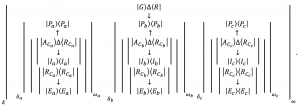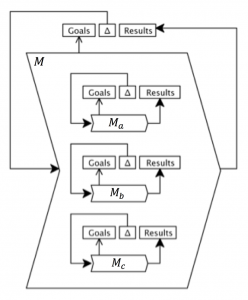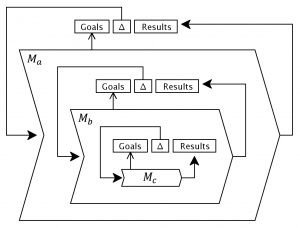This page is a sub-page of our page on Business Algebra.
///////
Blended training within a large company ecosystem:
Figure 26. Blended (internal + external) training at the operational level:

Figure 26 depicts three overall processes, an operational level production process for a large company (at the top), and two supporting training processes, internal training and external training. These refer respectively to the training processes that go on inside of respectively outside of the company.
The overall production process is shown broken up into three sub-processes called \, P_a, P_b, P_c . The overall training processes are modeled as broken up accordingly, i.e., into the sub-processes \, I_a, I_b, I_c \, for the internal training process respectively \, E_a, E_b, E_c \, for the external training process.
Moreover, let us define the parameters \, A_C \stackrel {\mathrm{def}}{=} A_{ctual}C_{ompetence} \, and \, R_C \stackrel {\mathrm{def}}{=} R_{equired}C_{ompetence} . Introducing the fork- and join-logics \, (\delta_a, \omega_a), (\delta_b, \omega_b), \, and \, (\delta_c, \omega_c) \, of the different parts and the overall fork- and join logics \, (\delta, \omega) \, we can represent the blended training strategy for the company by the following knowlecule:
This knowlecule is a three-step serialization. The knowlecule appearing at the top of each step is supported by the knowlecule appearing underneath the upward arrow for that step. The latter knowlecule consists of a two-channel parallelization, representing respectively the corresponding steps of the internal and the external training process. The fork-and join logics of parallellized knowlecules are discussed in chapter 22.5.
As modelled graphically in Figure 26, the structural difference between the internal and external drivers of the training processes involved is reflected in the fact that while the internal training processes are controlled by gaps (“deltas”) between the corresponding actual and required competences, in contrast, the external training process is controlled by the required competences alone. This reflects the fact that a company normally has more reliable knowledge about the actual competence of its own workers, and the internal training processes can therefore target the closing of these gaps.
In contrast, the external training processes cannot make any similar assumptions, and therefore external learners should be assessed on their performance with respect to the required competences alone. This means that the external training processes will tend to be more uniformly targeted, while the internal training processes will tend to be more individualized. This is natural also from the perspective of phronesis, since the internal training processes normally can rely on an implicit repository of tacit knowledge about the workplace and the company.
This is in fact the type of blending that is meant by the expression “blended training strategy”. In the future, company process training will be augmented in various ways. In many ways, for example, operating a numerically controlled machine has similarities with playing a computer game. These various forms of augmentation can be modeled by expressions such as \, \vert \, A_C \, \rangle \ast \langle \, R_C \, \vert \, where the operation \, \ast \, reflects the nature of the augmentation.
///////




After looking into a handful of the articles on your web site, I truly like your technique of writing a blog. I saved as a favorite it to my bookmark site list and will be checking back soon. Please visit my website as well and let me know your opinion.
Woah! I’m really enjoying the template/theme of this website. It’s simple, yet effective. A lot of times it’s tough to get that “perfect balance” between user friendliness and visual appeal. I must say you have done a fantastic job with this. In addition, the blog loads extremely quick for me on Internet explorer. Excellent Blog!